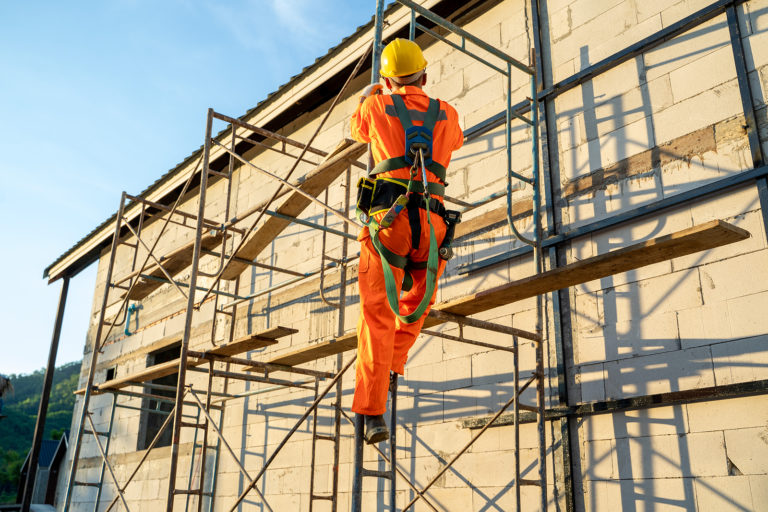Fall Protection Safety Requirements for Staff Working at Heights

You know, out of all work-related injuries every year, a distressing amount come from falls from above. But guess what? We can absolutely avoid these accidents! Workplaces need to be organized to limit the risk of workers taking a tumble from high platforms or workstations, or vanish into floor holes or wall gaps. Fall protection in the workplace must be of paramount concern and part of every company’s daily activity.
The big boss – OSHA insists that places working on construction need to have fall protection when the work is done six feet up. For general workplaces, it’s when you’re four feet high. Add to it, no matter how far you could fall, if you’re working above risky equipment – fall protection is a must!
What’s the best way to avoid hurting or losing workers from high falls? Rhyme it with me, “Cover every floor-hole, guard every open-sided platform!”. Regardless of the height, if there’s a risk of landing on or tumbling into dangerous machines or equipment (like an acid vat or conveyor belt), fall prevention is non-negotiable.
There could be jobs where other kinds of approved fall protection (like warning line systems, controlled access zones, safety monitor systems) might be needed.
While working on high platforms, fall protection can be given with guardrail systems, safety net systems, or personal fall protection systems. OSHA calls these the regular fall protection.
What else can help prevent falls? Choosing safe work habits, never veering from standard operating procedures (SOPs), and full participation during training!
Considering Fall Hazards Beforehand and Having a Solid Plan
Whether you’re assessing risks or planning for fall protection, it’s crucial to think ahead. Thinking of hazards before the job begins aids in managing these risks and emphasizing prevention.
Now, if you’re using personal fall protection systems, pay serious attention to identifying attachment spots. Make sure every worker knows the right way to use the equipment and how to inspect it.
Hazards When Working At Heights:
- Area near hoists
- Floor holes left uncovered
- Openings on roofs and elevators
- Skylights lacking ample protection
- The work form and reinforcing steel
- Inadequate surface for working
- Misused equipment, like scaffolds and ladders
Working near precarious spots like wall openings, leading edges, ramps, pits, and excavations:
During your safety gatherings or toolbox talks, discuss these crucial points about working at heights:
- If you’re working 6 feet above on a construction site, 4 feet above in an industry workspace, or something hazardous is beneath – you need fall protection.
- Confirm a fall prevention plan before any job.
- Make sure you have the right equipment for the job.
- Training for using the equipment safely is a must. Any doubts? Just ask!
- Inspect all your equipment before using – this includes your fall protection gear and other equipment you’re working with or from.
- And don’t forget to install a safety net!
Safety Net Placement
When you’re working high up, remember to place safety nets close by. These nets are crucial for your safety and, therefore, they shouldn’t be positioned any further than 30 feet below your standing point. You never know when you might need them, but you’ll be glad they’re there if you do.
Any time a gap shows up in the ground, act promptly and cover it. Just remember, what you use to guard the gap must be sturdy. Each cover should effortlessly uphold two times the load of human beings, bulky machines, and hefty materials that might end up on top.
Skylight Awareness
Skylights call for keen eyes. They seem safe but they’re really “holes”. Be careful! Skipping or stumbling over one means trouble. So avoid it all: don’t step on, stumble onto, or trip over them.
Proper Scaffold Assembly
Scaffold setup asks for full care. Follow the maker’s manual strictly. You’ll stay on track. Guardrail systems? Attach them, good move. Attach where? All open sides and platform ends. First concern, always? Safety, of course.
Ladder Safety Protocols
Ready to ascend the ladder? Inspect it first. Never ignore ladder safety rules. They keep you safe. Placement of extension ladder? 3 feet above the landing. Quick safety check? The ladder’s weight should never tip it off. Remember: Safety first, regrets never.
Added Protection for High-Climbing Workers
Are you in a lofty space? Need to lean out to get tools or materials? Be guarded. A personal fall arrest system is a must-have. This safety harness stops you from dropping through an unguarded opening. Don’t neglect your worker’s safety. It counts the most.
